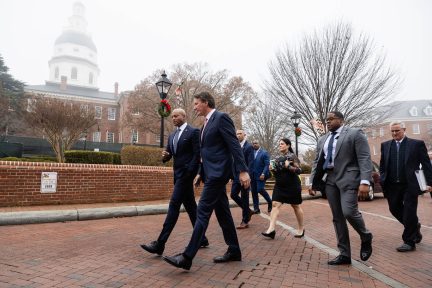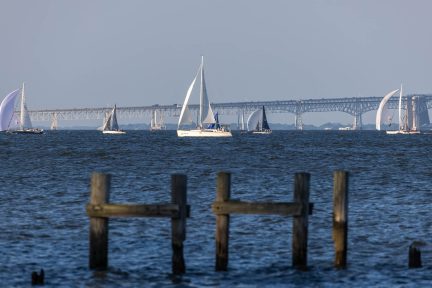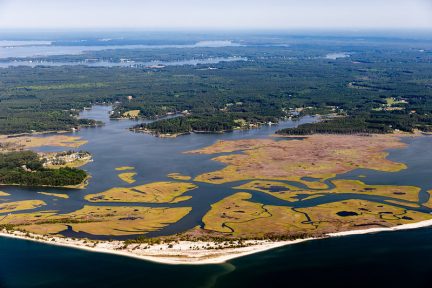Chesapeake Bay Program reports watershed-wide progress toward environmental education goals
The Chesapeake Bay Program is pleased to announce its partners are making progress toward the environmental education goals of the 2014 Chesapeake Bay Watershed Agreement.
The Chesapeake Bay Program is pleased to announce its partners are making progress toward the environmental education goals of the 2014 Chesapeake Bay Watershed Agreement. Sixteen years after the Chesapeake Executive Council formally recognized the importance of environmental education to the partnership, Delaware, Maryland, Pennsylvania, Virginia and Washington, D.C., agreed to help their students graduate with the knowledge and skills needed to protect and restore their local watersheds. Since 2015, school districts within these jurisdictions have reported a slight rise in their preparedness to put environmental education programs in place, as well as an increase in the number of schools that are operating sustainably and a steady level of curriculum-embedded opportunities for students to learn outside.
According to the results of a 2017 Chesapeake Bay Program survey, almost one-quarter of responding school districts in the watershed-portion of Delaware, Maryland, Pennsylvania, Virginia and Washington, D.C., consider themselves well-prepared to deliver high-quality environmental literacy programming to their students. More than one-third of responding school districts indicate their students are engaged in field experiences and outdoor learning through an inquiry-based approach toward education known as the Meaningful Watershed Educational Experience (MWEE). More than 600 public and charter schools in these jurisdictions are certified sustainable.
Despite this news, the Chesapeake Bay Program has identified three challenges that could hinder progress toward our environmental education goals. First, competing priorities and changes in leadership at the state and local level can create inconsistent support for environmental literacy. Second, teachers frequently lack the training and confidence to implement MWEEs. Third, school staff often perceive the act of seeking sustainable school recognition as daunting in light of their other responsibilities.
As a partnership that brings together government agencies, academic institutions and nonprofit organizations from across the watershed, the Chesapeake Bay Program is uniquely positioned to address these challenges. Earlier this year, the Principals’ Staff Committee committed to biennially convening high-level leaders in both education and the environment to discuss progress toward the partnership’s environmental education goals. In August, Chesapeake Executive Council Chair and Maryland Governor Larry Hogan called on his fellow watershed states to use the data and information collected by the Chesapeake Bay Program to develop strategies to equitably direct their resources toward ensuring all students have access to outdoor learning experiences and a sustainable school environment. The Chesapeake Bay Program will distribute its third environmental education survey to school districts in 2019.
Facts
The Chesapeake Bay Program uses its Environmental Literacy Indicator Tool to track partner progress toward their environmental education goals. This voluntary survey is distributed to school districts every two years. The 132 school districts in Delaware, Maryland, Pennsylvania, Virginia and Washington, D.C., that completed this survey serve 75 percent of the watershed’s public school students. In future years, collecting more survey responses from more school districts will give the Chesapeake Bay Program a more complete picture of environmental literacy in the watershed.
Environmental Literacy Preparedness
To measure environmental literacy preparedness across the region, the Chesapeake Bay Program asked survey respondents to indicate whether their districts had environmental education programs, established program leaders, methods of training teachers and administrators, and other elements critical to a comprehensive and systemic approach to environmental education. In 2017:
- Twenty-two percent of responding school districts—or 29 school districts in all—identified as well-prepared to put high-quality environmental literacy programming in place. These districts are located in the watershed-portion of Maryland and Virginia.
- Fifty-eight percent of responding school districts—or 76 school districts in all—identified as somewhat prepared to put high-quality environmental literacy programming in place. These districts are located in the watershed-portion of Delaware, Maryland, Pennsylvania, Virginia and Washington, D.C.
- Twenty percent of responding school districts—or 27 school districts in all—identified as not prepared to put high-quality environmental literacy programming in place. These districts are located in the watershed-portion of Delaware, Pennsylvania and Virginia.
This marks a slight increase in environmental literacy preparedness since the pilot Environmental Literacy Indicator Tool was distributed in 2015.
Student MWEEs
To measure student participation in Meaningful Watershed Educational Experiences across the region, the Chesapeake Bay Program asked survey respondents to describe the availability of MWEEs in their district’s elementary, middle and high schools. In the watershed-portion of Delaware, Maryland, Pennsylvania, Virginia and Washington, D.C., in 2017:
- Thirty-nine percent of responding school districts reported providing system-wide MWEEs to their elementary school students. Thirty-three percent reported providing some MWEEs to their elementary school students, while 28 percent reported providing none.
- Forty-three percent of responding school districts reported providing system-wide MWEEs to their middle school students. Thirty-four percent reported providing some MWEEs to their middle school students, while 23 percent reported providing none.
- Thirty-one percent of responding school districts reported providing system-wide MWEEs to their high school students. Fifty-one percent reported providing some MWEEs to their high school students, while 18 percent reported providing none.
Sustainable Schools
In 2017, 612 public and charter schools in the watershed-portion of Delaware, Maryland, Pennsylvania, Virginia and Washington, D.C., were certified sustainable by the U.S. Green Ribbon Schools, National Wildlife Federation Eco-Schools USA, Maryland Green Schools, Pennsylvania Pathways to Green Schools and Virginia Naturally Schools programs. This marks a 22 percent increase since 2015.
Issues
When asked to name their highest priority for improving environmental education programs, respondents to the Chesapeake Bay Program’s Environmental Literacy Indicator Tool survey agreed that funding, teacher training and professional development, and assistance integrating environmental topics into division curriculum topped the list. These findings have spurred the Chesapeake Bay Program to connect leaders in education with their natural resource counterparts and to share training materials and best practices across state lines. Continued progress will require stronger state commitments to the implementation of Meaningful Watershed Educational Experiences and a wider base of funding to support environmental literacy. The shape of continued support from the Chesapeake Bay Program will be informed by input collected through future ELIT surveys.
Importance
The Chesapeake Bay watershed is home to 2.7 million students in kindergarten through twelfth grade. Through the Chesapeake Bay Watershed Agreement, Delaware, Maryland, Pennsylvania, Virginia and Washington, D.C., have committed to helping their students graduate with the knowledge and skills needed to protect and restore their local watersheds. To do so, our partners are increasing opportunities for students to explore locally relevant environmental issues and practice environmental stewardship within their school communities, which boosts academic achievement and prepares students for life after school. By expanding the number of schools that reduce their impact on the natural world, our partners will benefit student health and allow them an active role in environmental protection. By teaching students to investigate and address environmental issues, our partners will nurture their sense of stewardship and encourage a lifetime of civic engagement. By developing comprehensive policies and practices to support environmental education, our partners will ensure current and future students graduate with an understanding of their relationship with the environment around them.
Quotes
“States and school districts are working hard to foster the next generation of Chesapeake Bay stewards. The information that they provided in this survey will help us to direct funding and resources to the places and programs where they will have the most impact.”
-- Sean Corson, Acting Director, National Oceanic and Atmospheric Administration Chesapeake Bay Office
“Helping provide the tools of lifelong learning for a next generation of environmental stewards will continue to be among our highest priorities. I’m proud to see Maryland schools are making progress in preparing our young people for their role in our shared mission: to preserve and protect our natural resources.”
-- Mark Belton, Secretary, Maryland Department of Natural Resources
"Maryland has always put a high priority on environmental education, in 2010 becoming the first State in the nation to include environmental education in our graduation requirements. Our environment is a gift to be protected, maintained, improved, and honored."
-- Dr. Karen M. Salmon, State Superintendent of Schools, State of Maryland
“Governor Wolf’s administration is making a concerted effort to actively involve teachers and school districts in professional development revolving around Meaningful Watershed Educational Experiences, which connect students with the environment through outdoor learning opportunities. There is a particular focus on incorporating science practices and standards utilizing STEM (Science, Technology, Engineering and Math). All of these activities support high-level teaching and learning for all students, ultimately benefiting both the Commonwealth and the Chesapeake Bay watershed.”
-- Pedro A. Rivera, Secretary, Pennsylvania Department of Education
“As a longtime supporter of and partner on environmental education in Pennsylvania, DEP knows that while many schools provide strong programs, many others would like to do more. Watershed education is one area of growing interest. We’re excited to be collaborating on new initiatives to increase development of watershed curricula, including the statewide Watershed Education Task Force and Chesapeake Bay Program Education Workgroup. As soon as children learn what a fish is, they should learn what a watershed is—and the role humans play in it.”
-- Patrick McDonnell, Secretary, Pennsylvania Department of Environmental Protection
“I am fortunate to have a great deal of firsthand experience with both formal and informal environmental education as an elementary science specialist and as community educator for an environmental non-profit. It is clear that STEM-based, outdoor learning opportunities provide hands-on, inquiry based, and project-based learning, which are the most innovative and inspiring methods to engage developing minds.”
-- Pamela Northam, First Lady, Commonwealth of Virginia
"Governor Northam’s commitment to environmental literacy will amplify our efforts to provide meaningful watershed education, foster a new generation of environmental stewards and make tangible improvements to our quality of life.”
-- Matthew J. Strickler, Secretary of Natural Resources, Commonwealth of Virginia
“Cultivating environmental literacy is key to protecting the future health of the District’s rivers, creeks and streams. The District Department of Energy and Environment works closely with our schools, sister agencies and nonprofit partners to create empowering opportunities both in and outside of the classroom for students to grow into environmental stewards and gain the skills they need to flourish as future leaders in the District.”
-- Tommy Wells, Director, District Department of Energy and Environment
“Environmental education for all ages is an integral part of our priorities for Delaware’s Department of Natural Resources and Environmental Control. We strongly support environmental education in our schools throughout the state to foster the next generation of environmental stewards. Learning about the vital importance of our watersheds and how we can help keep these precious natural resources healthy is a key component of environmental education – and one of the most important things we can teach our children to benefit their future and the future of our planet.”
-- Shawn M. Garvin, Secretary, Department of Natural Resources and Environmental Control, State of Delaware
“The future of the environment around us is in the hands of our youngest residents – our students. Delaware is committed to moving not only environmental education forward, but also to further science standards and practices utilizing STEM education. We are proud to cultivate environmental literacy in our students; to teach them about the interconnectedness of the natural world and how protecting the local waters in their backyard can impact the Chesapeake Bay – and far beyond.”
-- Susan Bunting, Secretary of Education, State of Delaware



